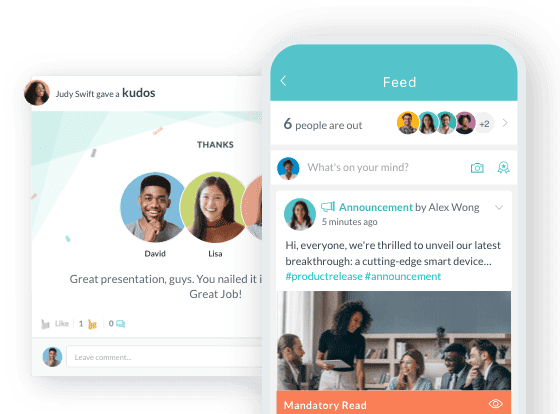Employee Engagement Intranet Tools: A Practical Buyer's Guide for 2025

- Why Employee Engagement Intranets Matter More Than Ever
- 10 Essential Capabilities Your Employee Engagement Intranet Must Have
- HR Cloud Workmates: Built for Real-World Employee Engagement
- Common Shortcomings in Popular Intranet Platforms
- The 6-Step Procurement Framework for Employee Engagement Intranet Software
- Real-World Implementation: 90-Day Employee Engagement Platform Success Framework
- Hypothetical Case Study: Mid-Size Retail Chain Implementation
- Why HR Cloud's Workmates Fits Modern Engagement Needs
- Measuring ROI: Essential Metrics and Dashboard KPIs
- Pricing Realities and Budget Planning for Employee Engagement Software
- 10 Common Implementation Mistakes to Avoid
- Transform Your Employee Engagement Strategy with the Right Intranet Platform

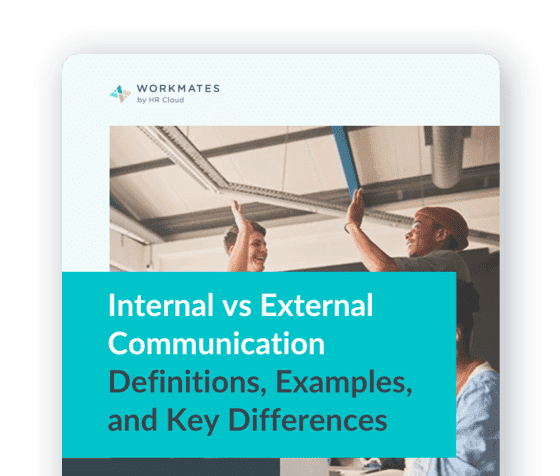
 Cut onboarding time
by 60%—here's the
Ultimate Checklist
that helped do it.
Cut onboarding time
by 60%—here's the
Ultimate Checklist
that helped do it.
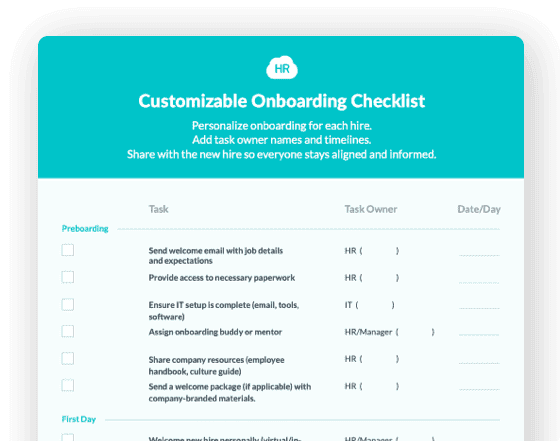
"We improved our communication effectiveness by 40% within the first 90 days of implementing our new intranet platform. The difference was night and day." — Anonymous HR Director at a 2,000-employee retail chain
That's the power of choosing the right employee engagement intranet tool. But with dozens of platforms promising similar outcomes, how do you separate genuine capability from marketing hype? The global employee engagement software market, valued at $1.8 billion in 2023, continues expanding as organizations seek digital workplace solutions that actually drive measurable workforce engagement improvements.
Modern businesses face a fundamental challenge: traditional internal communication methods fail distributed teams. Email overload affects 64% of knowledge workers according to recent productivity research, while 73% of frontline employees report feeling disconnected from company communications. Employee engagement intranet software addresses these pain points by creating centralized digital workplace platforms that combine internal communications, social recognition, and workforce analytics.
TL;DR
Employee engagement intranet tools have evolved from simple document repositories to comprehensive communication and engagement platforms. Modern solutions like HR Cloud's Workmates platform offer centralized newsfeeds, recognition systems, analytics, and mobile-first experiences that actually drive measurable engagement improvements. Key decision factors include mobile optimization, integration capabilities, analytics depth, and ease of administration. Most organizations see engagement improvements within 60-90 days when implementation follows best practices.
Key Takeaways
-
Mobile-first design isn't optional for modern workforces — 73% of frontline workers access company information primarily through mobile devices, making responsive intranet design critical for employee adoption success
-
Integration capabilities determine long-term ROI — platforms that seamlessly connect with existing HRIS systems, communication tools, and single sign-on solutions see 60% higher user adoption rates within the first quarter
-
Analytics must drive actionable insights — the best employee engagement platforms provide workforce analytics that translate directly into management decisions, with top-performing organizations tracking daily active users, content engagement rates, and recognition patterns
-
Recognition features significantly impact employee retention — companies with comprehensive peer-to-peer recognition systems see 31% lower voluntary turnover rates and 12% higher employee satisfaction scores
-
Implementation methodology matters more than software features — successful rollouts follow structured 90-day adoption plans with clear success metrics, dedicated change management resources, and executive sponsorship
Why Employee Engagement Intranets Matter More Than Ever
The modern workplace has fundamentally shifted, creating new challenges for internal communications and workforce engagement. Remote and hybrid teams require different communication strategies than traditional office environments. Gallup research indicates that organizations with highly engaged workforces are 21% more profitable and experience 40% lower absenteeism rates.
Traditional communication methods create information silos that cost businesses measurably. Email overload reduces productivity by an average of 2.5 hours per employee daily, according to McKinsey research. Bulletin boards reach limited audiences, important company announcements get buried in chat threads, and critical policy updates often miss their intended recipients entirely.
Employee engagement intranet solutions solve these workplace communication challenges by creating centralized, searchable, and accessible digital workplace hubs. However, the distinction between legacy systems and modern engagement platforms is crucial for procurement decisions.
What separates effective engagement platforms from digital filing cabinets:
Legacy intranet systems often become document graveyards that employees actively avoid. Modern workforce engagement platforms, however, incorporate social collaboration features, peer recognition systems, real-time analytics, and mobile-first user experiences that create genuine behavioral change and measurable business outcomes.
Research from Deloitte demonstrates that companies with connected workplace cultures see 5x higher revenue growth rates and 40% lower employee turnover compared to organizations with fragmented internal communications strategies.
10 Essential Capabilities Your Employee Engagement Intranet Must Have
What features should you prioritize when evaluating employee engagement intranet software? Modern workforce engagement platforms require specific capabilities to drive measurable business outcomes. Based on analysis of successful implementations across various industries, these ten features represent the minimum requirements for effective digital workplace transformation.
When comparing employee engagement intranet vendors, use this comprehensive checklist to evaluate platform capabilities, ensure long-term scalability, and maximize your software investment ROI.
1. Mobile-First User Experience for Frontline Workers
Your frontline employees — whether in retail, healthcare, manufacturing, or hospitality — access company information primarily through smartphones and tablets. According to SHRM workforce communication research, 68% of deskless workers report feeling disconnected from company communications, directly impacting employee engagement scores and operational efficiency.
Essential mobile intranet features include:
-
Responsive mobile interfaces optimized for small screens
-
Push notifications for urgent announcements and recognition
-
Offline content access for areas with limited connectivity
-
Touch-friendly navigation designed for thumb interaction
-
Fast loading times under 3 seconds on mobile networks
Look for employee engagement platforms with robust mobile functionality that works seamlessly across iOS and Android devices. HR Cloud's Workmates platform offers comprehensive mobile functionality including chat capabilities, announcement viewing, recognition features, and survey participation through mobile-optimized interfaces designed specifically for frontline workforce needs.
Why mobile-first design matters for employee engagement: Organizations with mobile-optimized internal communications see 67% higher employee participation rates in company initiatives and 45% faster information distribution compared to desktop-only intranet solutions.
2. Comprehensive Integration Ecosystem for Enterprise Systems
Your employee engagement intranet software shouldn't exist in isolation from your existing technology stack. Seamless system integration reduces administrative overhead, prevents data silos, and ensures consistent user experiences across your digital workplace ecosystem.
Critical integration requirements include:
HRIS and Human Capital Management Systems
-
ADP, Workday, UKG for automatic employee data synchronization
-
Real-time employee directory updates and organizational chart management
-
Automated onboarding and offboarding workflow triggers
Communication and Collaboration Tools
-
Integration with primary communication tools (Microsoft Teams, Slack, etc.)
-
Email connectivity for notification delivery
-
Support for video conferencing and collaboration platforms your organization uses
Single Sign-On and Security Providers
-
OKTA, Azure Active Directory, SAML-based authentication systems
-
Multi-factor authentication support for enterprise security compliance
-
Role-based access control synchronized with existing permission structures
Business Application Connectors
-
CRM systems, project management tools, and scheduling software
-
Document management systems and knowledge bases
-
Analytics platforms and business intelligence tools
HR Cloud supports extensive enterprise integrations including ADP, Microsoft Teams, Slack, OKTA, and SAML-based SSO systems. These pre-built connectors enable organizations to maintain existing workflows while adding comprehensive employee engagement capabilities without requiring custom development or API integration costs.
Integration success metrics: Companies with fully integrated employee engagement platforms report 73% faster user adoption rates and 58% reduction in help desk tickets related to system access issues.
3. Social Recognition and Rewards Systems for Employee Motivation
Employee recognition drives workforce engagement more effectively than most other human resources interventions. Research from Gallup demonstrates that employees who receive regular recognition are 3x more likely to be engaged at work and 5x more likely to stay with their organization long-term.
Essential recognition platform features:
Peer-to-Peer Recognition Capabilities
-
Customizable badges and recognition categories aligned with company values
-
Social recognition feeds that celebrate achievements publicly
-
Point-based rewards systems with gift card or merchandise redemption
-
Team-based recognition campaigns for collaborative achievements
Manager-to-Employee Appreciation Workflows
-
Structured feedback delivery with recognition tracking
-
Performance milestone celebrations and anniversary acknowledgments
-
Goal achievement recognition with automated notifications
-
Leadership appreciation programs for high-performing teams
Recognition Analytics and Insights
-
Recognition frequency reports by department and location
-
Employee sentiment tracking through appreciation patterns
-
Manager participation rates in recognition activities
-
ROI measurement through engagement correlation analysis
Workmates includes comprehensive employee recognition features called "Kudos" that enable peer-to-peer recognition with virtual high-fives, custom recognition badges, and detailed analytics to track appreciation patterns across departments, locations, and reporting structures.
Recognition impact on business outcomes: Organizations with structured recognition programs experience 14% higher employee productivity, 18% higher customer satisfaction scores, and 12% reduction in absenteeism rates according to workplace psychology research.
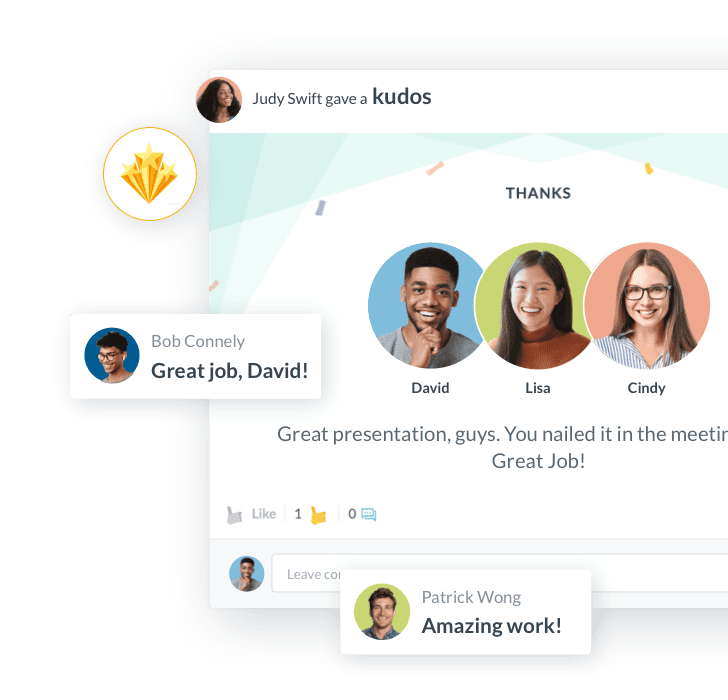
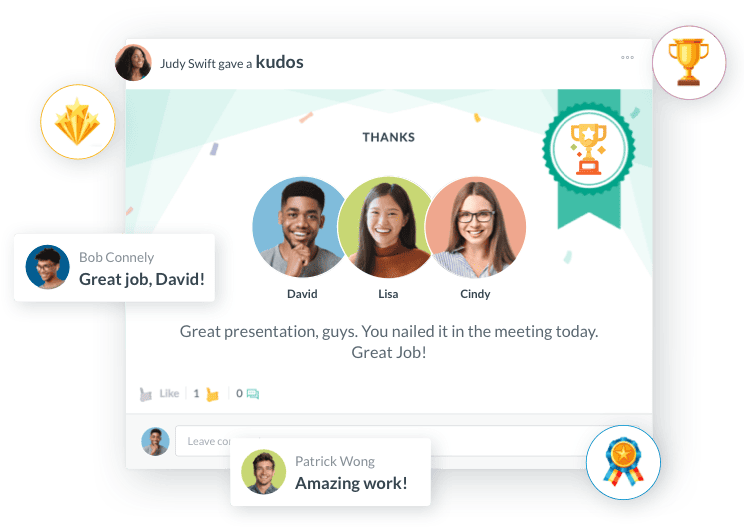
4. Targeted Communication and Announcement Capabilities
Generic company-wide announcements often miss their intended audience. Modern platforms should enable:
-
Role-based content targeting (by department, location, or job function)
-
Mandatory read acknowledgments with tracking
-
Scheduled content publishing
-
Multi-format content support (text, images, videos, documents)
5. Advanced Analytics and Engagement Insights for Data-Driven Decisions
Workforce analytics without actionable insights wastes valuable human resources budget. Modern employee engagement platforms must provide comprehensive data visualization, trend analysis, and automated reporting capabilities that enable strategic workforce management decisions.
Essential analytics capabilities for employee engagement measurement:
User Engagement Metrics and Benchmarking
-
Daily and monthly active user tracking with industry benchmarks
-
Content engagement rates, read receipts, and interaction analytics
-
Feature adoption curves and usage pattern identification
-
Department and location-based engagement comparisons with statistical significance
Engagement Trend Analytics for Workforce Planning
-
Employee satisfaction trend tracking with historical pattern analysis
-
Recognition pattern monitoring to identify employees who may benefit from additional outreach
-
Communication effectiveness measurement with actionable insights
-
Engagement metric correlation analysis to support retention planning
Executive Dashboard and Reporting Automation
-
Real-time workforce engagement scorecards for leadership teams
-
Automated monthly engagement reports with variance analysis
-
Custom KPI tracking aligned with business objectives
-
Data export capabilities for advanced analytics and business intelligence integration
Workmates Analytics provides detailed engagement reporting that helps HR teams identify highly active employees, regular participants, and team members who may benefit from additional outreach, enabling data-driven retention strategies. This behavioral segmentation helps HR administrators focus retention efforts effectively and measure engagement improvement initiatives.
Analytics ROI for workforce management: Organizations using advanced employee engagement analytics report 23% improvement in workforce planning accuracy and 31% faster identification of potential retention risks compared to companies relying on annual surveys alone.
6. Content Management and Governance Tools
Information chaos kills engagement. Look for:
-
Drag-and-drop page creation interfaces for non-technical staff
-
Content approval workflows
-
Version control and content archiving
-
Search functionality with tagging and categorization
7. Real-Time Communication Features
Modern teams need instant communication options:
-
One-on-one and group chat functionality
-
Channel-based communication (similar to Slack or Teams)
-
File sharing with version control
-
Integration with existing communication tools
Workmates provides built-in communication features and integrates with enterprise collaboration tools like Slack and Microsoft Teams, helping employees stay connected while maintaining centralized engagement records.
8. Survey and Feedback Mechanisms
Continuous feedback improves both engagement and platform effectiveness:
-
Anonymous survey capabilities
-
NPS (Net Promoter Score) tracking
-
Custom questionnaire creation
-
Real-time results and analytics


9. Enterprise Security and Compliance
Security can't be an afterthought:
-
Role-based access controls and permissions
-
Audit logs for content and user activity
-
Data encryption in transit and at rest
-
Security features that support your industry's compliance requirements (GDPR, SOC 2, etc.)
10. Scalable Administration and Support
As your organization grows, administration shouldn't become more complex:
-
Bulk user management capabilities
-
Automated onboarding and offboarding workflows
-
Custom branding and white-label options
-
Comprehensive training and support resources
Ready to evaluate these capabilities in action? Book a personalized Workmates demo to see how they work in practice.
Essential Features Comparison Matrix
|
Capability |
HR Cloud |
Simpplr |
Workvivo |
LumApps |
SharePoint |
Blink |
|
Mobile-First Design |
✅ Native |
✅ Good |
⚠️ Performance Issues |
✅ Responsive |
❌ Limited |
✅ Excellent |
|
Recognition System |
✅ Comprehensive Kudos |
⚠️ Basic |
✅ Strong |
❌ Limited |
❌ None |
✅ Peer Recognition |
|
HRIS Integration |
✅ ADP + Others |
⚠️ Challenges |
✅ Good |
✅ Enterprise |
✅ Some |
❌ Limited |
|
Analytics Depth |
✅ User Segmentation |
✅ AI-Powered |
✅ Metrics |
✅ Advanced |
❌ Basic |
⚠️ Basic |
|
Admin Simplicity |
✅ Drag-and-Drop |
✅ User-Friendly |
⚠️ Complex |
❌ Steep Curve |
❌ Very Complex |
✅ Simple |
|
Content Governance |
✅ Built-in |
⚠️ Workarounds |
✅ Good |
✅ Advanced |
✅ Advanced |
⚠️ Basic |
HR Cloud Workmates: Built for Real-World Employee Engagement
HR Cloud's Workmates platform stands out in the crowded intranet market through practical design choices that address actual workplace communication challenges:
Mobile-First Architecture Unlike platforms that adapted desktop interfaces for mobile use, Workmates was designed from the ground up for smartphone access. This matters significantly for frontline workers who depend on mobile devices for work communication.
Seamless Integration Strategy Workmates connects natively with major enterprise systems including ADP, Microsoft Teams, Slack, OKTA, and SAML-based SSO providers. These aren't bolt-on features but core architectural components that ensure data flows smoothly between systems.
Practical Recognition Framework The Kudos system goes beyond basic peer recognition. Employees can create custom badges, track recognition analytics, and tie recognition events to specific company values or achievements.
User-Centric Analytics Workmates Analytics categorizes engagement into actionable segments: Contributors (content creators), Participants (active engagers), Viewers (content consumers), and Dormant Users (requiring attention). This segmentation helps administrators focus improvement efforts effectively.
Simplified Content Management The drag-and-drop interface enables non-technical staff to create and maintain content without IT intervention. This democratization of content creation keeps information fresh and relevant.
Common Shortcomings in Popular Intranet Platforms
Understanding where established platforms struggle helps explain why organizations switch solutions or experience adoption challenges:
Simpplr: Integration and Customization Limitations
User reviews consistently highlight Simpplr's integration challenges, particularly with specialized HRIS systems and custom workflows. Many organizations report difficulty achieving the level of customization needed for their specific processes. The platform's content governance features, while present, often require workarounds for complex approval workflows that larger organizations need.
Workvivo: Mobile Performance and Admin Challenges
Despite marketing itself as mobile-first, Workvivo users frequently report mobile performance issues including notification delays and limited administrative capabilities on mobile devices. This creates problems for managers who need to respond quickly to employee communications while away from their desks. The platform also struggles with complex organizational structures that require nuanced permission settings.
LumApps: Steep Learning Curve and Limited Flexibility
LumApps users commonly cite the platform's complexity as a barrier to adoption. The administrative interface requires significant training, and content creators often struggle with the publishing workflow. Integration setup, while comprehensive, typically requires technical expertise that many HR teams lack. Users also report frustration with limited customization options for content layouts and user interfaces.
Microsoft SharePoint: Poor User Experience and Mobile Limitations
While SharePoint offers deep Microsoft ecosystem integration, user experience remains its biggest weakness. Employees consistently rate SharePoint intranets poorly for usability, and mobile functionality is particularly limited. Content organization becomes unwieldy as information volume grows, making it difficult for employees to find relevant information quickly. The platform's complexity often requires dedicated SharePoint administrators.
Blink: Limited Enterprise Features and Integration Depth
Blink excels for frontline communication but lacks the enterprise features larger organizations need. Integration capabilities remain limited compared to platforms designed for complex organizational structures. Analytics functionality is basic, providing limited insights for strategic decision-making. Organizations often outgrow Blink's capabilities as their communication needs become more sophisticated.
Interact: Customization Constraints and Setup Complexity
Users report frustration with Interact's rigid content structures that don't adapt well to unique organizational needs. The platform requires extensive technical setup for optimal performance, and ongoing maintenance often demands more IT resources than expected. Mobile functionality, while present, feels like an afterthought rather than a core feature.
Platform Strengths and Weaknesses Summary
|
Platform |
Strengths |
Common User Complaints |
Best For |
|
HR Cloud Workmates |
Mobile-first design, extensive integrations, user-friendly admin interface, comprehensive analytics |
Limited brand recognition compared to enterprise vendors |
SMB to mid-market organizations seeking comprehensive engagement platform |
|
Simpplr |
Polished UI, AI-powered search, good analytics |
Integration difficulties, limited customization, content governance gaps |
Organizations prioritizing search and content discovery |
|
Workvivo |
Strong culture-building tools, social features |
Mobile performance issues, complex admin setup, notification delays |
Companies focused on social engagement and culture building |
|
LumApps |
Enterprise adoption, Microsoft integration |
Steep learning curve, limited flexibility, complex setup |
Large enterprises with dedicated IT resources |
|
Microsoft SharePoint |
Deep Microsoft integration, included with Office 365 |
Poor user experience, limited mobile functionality, complexity |
Microsoft-heavy organizations with technical resources |
|
Blink |
Excellent for frontline workers, simple interface |
Limited enterprise features, basic analytics, integration constraints |
Frontline-focused organizations with simple needs |
The 6-Step Procurement Framework for Employee Engagement Intranet Software
How do you evaluate and purchase employee engagement intranet software? This comprehensive procurement methodology helps organizations make informed vendor selection decisions, negotiate favorable contract terms, and ensure successful platform implementation with measurable ROI.
Follow this step-by-step evaluation process to select the best employee engagement platform for your organization:
Step 1: Define Success Metrics
Before evaluating vendors, establish clear measurements:
-
Engagement targets: Daily active users, content interaction rates
-
Communication effectiveness: Reduction in email volume, faster information distribution
-
Business outcomes: Employee satisfaction scores, turnover reduction, onboarding efficiency
-
Usage patterns: Mobile adoption, cross-departmental interaction
Step 2: Map Technical Requirements
Create a comprehensive technical checklist:
-
Infrastructure compatibility: Cloud vs on-premises requirements
-
Integration necessities: Must-have vs nice-to-have system connections
-
Security standards: Industry compliance requirements
-
Scalability needs: User growth projections over 3-5 years
Step 3: Conduct Realistic Pilot Testing
Run 30-60 day pilots with actual use cases:
-
Frontline scenario testing: Mobile access during shifts, offline capabilities
-
Administrative workflows: Content publishing, user management, analytics review
-
Integration validation: Real data flow between systems
-
User experience assessment: Actual employee feedback on usability
Step 4: Measure Adoption Metrics
Track leading indicators of success:
-
Week 1-2: Login frequency, profile completion rates
-
Week 3-6: Content interaction, recognition usage
-
Week 7-12: Cross-department engagement, feature adoption depth
-
Ongoing: Satisfaction surveys, business impact measurements
Step 5: Calculate Total Cost of Ownership
Beyond licensing fees, consider:
-
Implementation costs: Setup, data migration, customization
-
Training expenses: Administrator and end-user education
-
Ongoing support: Technical support, content management time
-
Integration maintenance: API updates, system compatibility
Step 6: Plan Change Management
Technology alone doesn't drive adoption:
-
Champion identification: Find enthusiastic early adopters in each department
-
Communication strategy: Pre-launch awareness, benefits messaging
-
Training programs: Role-specific education and ongoing support
-
Feedback loops: Regular check-ins and platform improvements
Implementation Complexity Assessment
|
Platform |
Setup Complexity |
Training Required |
IT Resources Needed |
Time to Value |
|
HR Cloud Workmates |
Low to Moderate |
Minimal |
Low |
2-4 weeks |
|
Simpplr |
Moderate |
Moderate |
Moderate |
4-6 weeks |
|
Workvivo |
Moderate |
Moderate |
Moderate |
3-5 weeks |
|
LumApps |
High |
Extensive |
High |
6-8 weeks |
|
SharePoint |
Very High |
Extensive |
Very High |
8-12 weeks |
|
Blink |
Low |
Minimal |
Low |
1-2 weeks |
Real-World Implementation: 90-Day Employee Engagement Platform Success Framework
How long does employee engagement intranet implementation take? Most organizations achieve full platform adoption within 90 days using structured change management methodologies. This proven implementation framework reduces time-to-value, minimizes user resistance, and ensures sustainable engagement improvements.
What are the critical phases of employee engagement software implementation?
The most successful deployments follow a three-phase approach with specific milestones, deliverables, and success metrics at each stage.
Weeks 1-2: Foundation Setting
Leadership Alignment
-
Executive sponsor identification and communication plan
-
Success criteria agreement and measurement baseline establishment
-
Change management team formation
Technical Preparation
-
System integration testing and data validation
-
Content migration strategy and initial content creation
-
User access provisioning and security configuration
Weeks 3-6: Pilot Launch and Refinement
Controlled Rollout
-
Department-by-department or location-based pilot launches
-
Champion training and feedback collection
-
Content strategy implementation and engagement monitoring
Optimization Phase
-
User feedback integration and platform adjustments
-
Integration fine-tuning and workflow improvements
-
Success metric tracking and reporting establishment
Weeks 7-12: Full Deployment and Adoption Drive
Organization-Wide Launch
-
Company-wide communication campaign and training programs
-
Gamification elements and recognition program launch
-
Department-specific use case development
Sustaining Momentum
-
Regular engagement measurement and improvement initiatives
-
Advanced feature introduction and user education
-
Long-term adoption strategy development
Hypothetical Case Study: Mid-Size Retail Chain Implementation
Note: The following represents a realistic but hypothetical scenario based on typical implementation patterns. Specific metrics are illustrative rather than representing actual customer results.
Organization Profile: 2,000-employee retail chain with 45 locations across three states
Challenge: Inconsistent communication between corporate headquarters and store locations led to policy confusion, low engagement scores (38% in annual survey), and higher-than-average turnover rates.
Solution: Implementation of a comprehensive intranet platform with mobile-first design, recognition features, and location-based communication channels.
Implementation Timeline: 90-day rollout following structured change management approach
Hypothetical Results (measured at 6-month post-implementation):
-
Employee engagement scores increased from 38% to 61%
-
Internal communication effectiveness ratings improved by 45%
-
Policy acknowledgment rates reached 94% (previously unmeasured)
-
Voluntary turnover decreased by 18% year-over-year
-
Mobile platform adoption reached 76% within first 90 days
Key Success Factors:
-
Store manager buy-in and champion training
-
Mobile-optimized content designed for busy retail environments
-
Recognition program tied to customer service metrics
-
Location-specific communication channels for relevant updates
This scenario illustrates typical implementation patterns but represents hypothetical rather than actual customer data.
Why HR Cloud's Workmates Fits Modern Engagement Needs
HR Cloud's Workmates platform addresses common intranet implementation challenges through focused functionality and proven integration capabilities:
Centralized Communication Hub Workmates provides a unified newsfeed where announcements, employee spotlights, surveys, and company updates appear in chronological order, ensuring important information doesn't get lost in email chains or separate systems.
Mobile-Optimized Design Built with frontline workers in mind, Workmates offers full functionality through mobile-responsive interfaces, enabling shift workers and remote employees to stay connected regardless of location or device.
Comprehensive Recognition System The built-in Kudos feature supports peer-to-peer recognition with customizable badges, enabling organizations to reinforce company values and celebrate achievements in real-time.
Extensive Integration Capabilities Pre-built connectors with ADP, Microsoft Teams, Slack, OKTA, and other enterprise systems ensure Workmates enhances rather than complicates existing workflows.
Actionable Analytics Workmates Analytics categorizes user engagement into Contributors, Participants, Viewers, and Dormant Users, providing clear insights for improving adoption and identifying communication gaps.
Enterprise-Ready Security SAML-based single sign-on, role-based permissions, and enterprise-grade security ensure Workmates meets security requirements while maintaining user-friendly access.
Experience Workmates capabilities firsthand with a personalized demo tailored to your organization's specific needs.
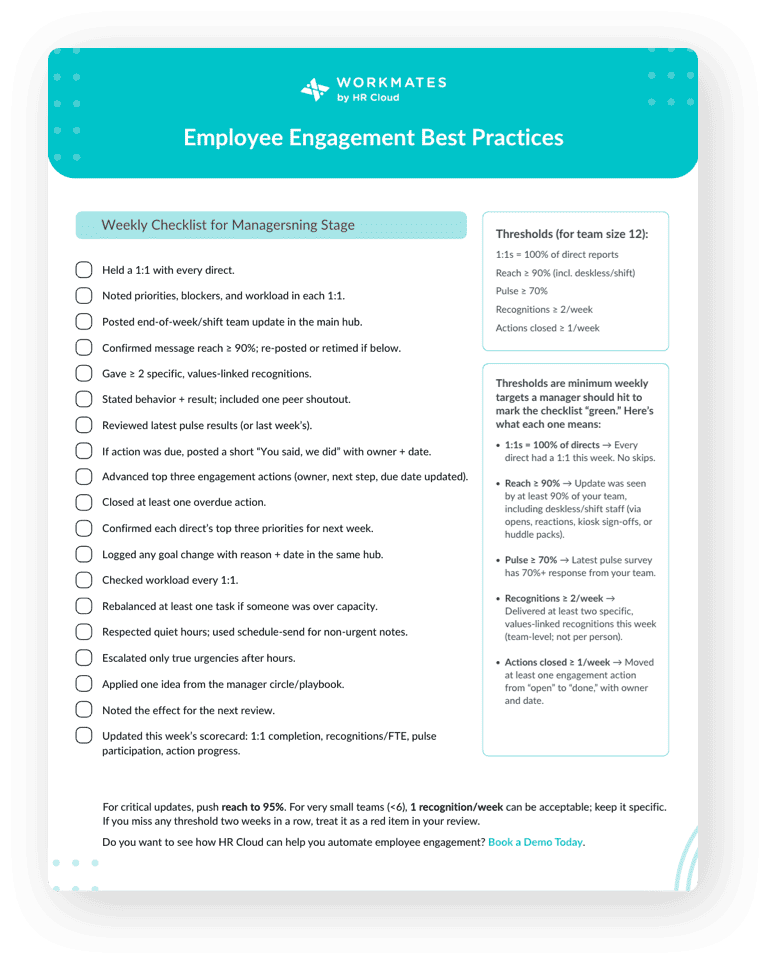
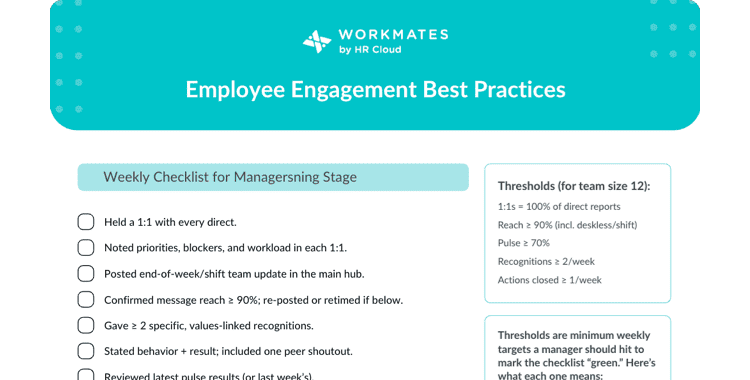
Measuring ROI: Essential Metrics and Dashboard KPIs
Engagement Metrics
Daily and Monthly Active Users (DAU/MAU)
-
Target: 70%+ DAU within first 90 days
-
Formula: (Daily unique users / Total registered users) × 100
Content Engagement Rate
-
Target: 60%+ for company announcements
-
Formula: (Views + Comments + Reactions) / Total eligible users × 100
Recognition Activity
-
Target: Average 2+ recognitions given per employee per month
-
Measurement: Total recognition events / Total active users / Time period
Communication Effectiveness
Information Reach
-
Target: 90%+ acknowledgment for mandatory communications
-
Formula: Confirmed reads / Total intended recipients × 100
Response Time Improvements
-
Target: 50% reduction in question response time
-
Measurement: Average hours from question to answer
Email Volume Reduction
-
Target: 30% decrease in internal email
-
Measurement: Email system metrics comparison

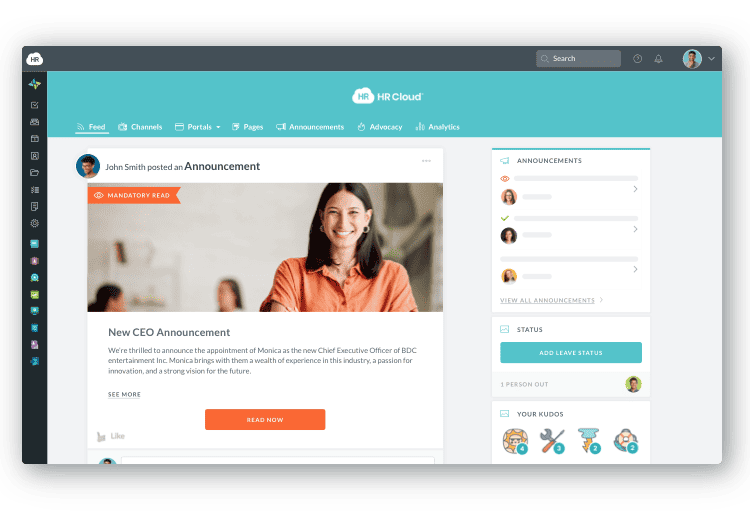
Business Impact Indicators
Employee Net Promoter Score (eNPS)
-
Target: 20+ point improvement within 6 months
-
Formula: (% Promoters - % Detractors)
Onboarding Efficiency
-
Target: 25% faster time-to-productivity
-
Measurement: Days from start date to full productivity
Voluntary Turnover Correlation
-
Target: Engaged employees show 40% lower turnover
-
Analysis: Engagement score correlation with retention rates
Pricing Realities and Budget Planning for Employee Engagement Software
How much does employee engagement intranet software cost? Understanding total cost of ownership, hidden implementation fees, and ongoing operational expenses is crucial for accurate budget planning and vendor comparison. Employee engagement platform pricing varies significantly based on user count, feature requirements, integration complexity, and support level needs.
Understanding Total Cost Structure for Employee Engagement Platforms
Software Licensing and Subscription Costs Most employee engagement intranet vendors charge between $6-15 per user per month, but pricing models vary significantly based on feature sets, advanced analytics capabilities, custom integrations, and premium support levels. Enterprise features like custom workflow automation, and dedicated customer success management often require higher-tier subscription plans with annual contract commitments.
Implementation and Professional Services Expenses Budget 15-25% of first-year licensing costs for professional implementation services, including:
-
Data migration from legacy systems and content organization
-
Custom configuration, branding, and user interface customization
-
Integration development, API testing, and system connectivity validation
-
Initial administrator training, change management consulting, and user adoption programs
Ongoing Operations and Maintenance Costs Factor in monthly operational expenses for sustained platform success:
-
Content creation and management (typically 0.1-0.2 FTE for organizations under 1,000 employees)
-
System administration, user support, and technical maintenance
-
Integration maintenance, software updates, and security patch management
-
Continuous training programs and platform optimization initiatives
Hidden Costs to Watch
Integration Complexities Some vendors charge additional fees for premium integrations or require custom development for specific system connections. Clarify integration costs upfront, especially for specialized HRIS or communication tools.
User Tier Limitations Many platforms offer different feature sets for different user types. Ensure frontline workers have access to necessary features, not just administrative users.
Support and Training Premium support, implementation assistance, and ongoing training often require separate contracts. Factor these costs into total budget planning.
Cost Structure Overview
|
Platform |
License Range |
Implementation |
Integration Costs |
Ongoing Support |
|
HR Cloud Workmates |
Contact for pricing |
Included |
Standard integrations included |
Comprehensive |
|
Simpplr |
$8-12/user/month |
$10-25K |
Additional for custom |
Tiered plans |
|
Workvivo |
$7-10/user/month |
$5-20K |
Some additional costs |
Good support |
|
LumApps |
$10-15/user/month |
$15-50K |
Enterprise integration fees |
Premium support |
|
SharePoint |
Included with O365 |
$20-100K+ |
Significant for customization |
Microsoft support |
|
Blink |
$6-8/user/month |
$5-15K |
Limited options |
Basic support |
Get transparent pricing information and implementation cost estimates for Workmates based on your specific requirements.
10 Common Implementation Mistakes to Avoid
1. Inadequate Change Management
Mistake: Assuming employees will naturally adopt new technology Solution: Develop comprehensive communication and training plans with clear benefits messaging
2. Poor Content Strategy
Mistake: Migrating existing documents without reorganization Solution: Curate content for relevance and create fresh, engaging material
3. Insufficient Mobile Testing
Mistake: Focusing only on desktop experience during evaluation Solution: Test all features on actual devices your employees use
4. Wrong Pilot Population
Mistake: Testing only with tech-savvy early adopters Solution: Include representative users from all departments and tech comfort levels
5. Governance Gaps
Mistake: Unclear content ownership and approval processes Solution: Establish clear roles and workflows before launch
6. Integration Oversights
Mistake: Treating integrations as "nice-to-have" features Solution: Test all critical integrations thoroughly during pilot phase
7. Metrics Confusion
Mistake: Tracking vanity metrics instead of business outcomes Solution: Focus on engagement quality and business impact, not just usage volume
8. Training Shortcuts
Mistake: Providing minimal training to save time Solution: Invest in comprehensive, role-specific training programs
9. Feature Overload
Mistake: Enabling every available feature at launch Solution: Start with core functionality and add features based on adoption
10. Champion Neglect
Mistake: Expecting platform success without local advocates Solution: Identify and train champions in each department or location
Transform Your Employee Engagement Strategy with the Right Intranet Platform
Modern workforces require sophisticated digital workplace solutions that go far beyond traditional document management systems. Employee engagement intranet tools have evolved into comprehensive workforce engagement platforms that genuinely improve workplace connection, internal communications effectiveness, and measurable business productivity.
The organizations achieving the strongest results from their employee engagement software investments share common implementation characteristics: they prioritize mobile-first platform architecture, emphasize comprehensive integration capabilities with existing enterprise systems, implement structured change management methodologies, and measure success through concrete business outcomes rather than vanity usage statistics.
What makes employee engagement intranet software successful:
HR Cloud's Workmates platform exemplifies this evolution, combining essential intranet functionality with robust workforce engagement features, comprehensive analytics dashboards, and enterprise-ready integration capabilities. However, the platform selection process matters less than implementation quality, dedicated change management resources, and ongoing organizational commitment to employee connection and communication excellence.
Key success factors for employee engagement platform ROI:
-
Executive sponsorship and visible leadership engagement
-
Dedicated change management resources and user training programs
-
Mobile-first design optimized for frontline workforce needs
-
Comprehensive integration with existing HRIS and communication systems
-
Data-driven adoption measurement and continuous improvement processes
Start your employee engagement software evaluation with clearly defined success criteria, conduct realistic pilot testing with actual use cases, and plan comprehensive change management from day one. Your employees and your measurable business outcomes will benefit significantly from strategic workforce engagement platform investment.
Organizations that invest in modern employee engagement intranet solutions typically see 15-25% improvement in employee satisfaction scores, 30-40% reduction in internal communication friction, and 20-35% faster onboarding completion times within the first year of implementation.
Schedule a personalized Workmates demonstration to explore how modern employee engagement platforms can transform your organization's communication effectiveness and workforce connection strategy.
Frequently Asked Questions About Employee Engagement Intranet Software
Do employee engagement intranet tools work for deskless workers and frontline employees?
Yes, modern employee engagement intranet platforms are specifically designed for frontline and deskless workers across retail, healthcare, manufacturing, and hospitality industries. Mobile-first platforms like HR Cloud's Workmates provide comprehensive functionality through smartphones and tablets, including real-time communication, peer recognition, company announcements, and survey participation. The key is choosing workforce engagement software built for mobile use rather than desktop-first solutions adapted for mobile devices.
What integrations are absolutely essential for employee engagement software?
The most critical integrations for employee engagement platforms include HRIS systems (for automatic employee data synchronization), single sign-on providers (for seamless user authentication), and primary communication tools (Microsoft Teams, Slack for workflow integration). Additional valuable integrations include payroll systems, employee scheduling tools, video conferencing platforms, and performance management software. HR Cloud supports major enterprise systems including ADP, OKTA, Microsoft Teams, and Slack through pre-built connectors.
How long does it take to see employee engagement improvements from intranet software?
Organizations typically observe initial engagement indicators within 2-4 weeks including increased login frequency and employee profile completion rates. Meaningful engagement improvements become apparent within 60-90 days through metrics like content interaction rates, recognition activity, and cross-departmental communication. Full cultural impact and measurable business outcomes usually emerge within 6 months. Success timeline depends heavily on change management quality, executive sponsorship, and dedicated user training programs.
Can organizations measure actual ROI from employee engagement intranet platforms?
Yes, measurable ROI from employee engagement software comes from quantifiable improvements including reduced voluntary turnover costs, improved onboarding efficiency, decreased IT support ticket volume, and enhanced internal communication effectiveness. Organizations commonly track employee net promoter scores, time-to-information metrics, productivity indicators, and recognition participation rates. Establishing baseline measurements before implementation is essential for accurate ROI calculation and platform success validation.
How do organizations ensure long-term adoption success with employee engagement software?
Sustained platform adoption requires ongoing content freshness, regular feature training sessions, continuous user feedback collection, and visible leadership engagement. Successful organizations treat their employee engagement intranet as a comprehensive communication strategy rather than just technology implementation, dedicating resources for content management, community building, and user experience optimization.
What's the difference between traditional intranet software and employee experience platforms?
Modern employee engagement intranets incorporate comprehensive experience platform features including peer recognition systems, social interaction capabilities, workforce analytics, and personalized content delivery. Traditional intranets focus primarily on document management and static information sharing. Today's best workforce engagement solutions combine traditional intranet functionality with social collaboration tools, real-time analytics, and mobile-first user experiences designed for diverse work environments.
Is custom software development usually necessary for employee engagement platforms?
Most organizations achieve success with out-of-the-box functionality and standard integration packages. Custom development typically becomes necessary only for unique workflow requirements, proprietary system integrations, or specialized compliance needs. Modern platforms like Workmates offer extensive customization through administrative configuration rather than requiring coding or technical development resources.
How do organizations handle security and compliance concerns with employee engagement software?
Enterprise-grade employee engagement platforms provide comprehensive security features including role-based access controls, detailed audit logging, end-to-end data encryption, and industry compliance certifications. HR Cloud offers SAML-based single sign-on, enterprise security standards, and granular permission management systems. Organizations should collaborate with IT security teams to validate platform requirements during vendor evaluation and contract negotiation processes.
Security and Compliance Features Comparison
|
Platform |
SSO Support |
Audit Logging |
Data Encryption |
Compliance Certifications |
|
HR Cloud Workmates |
SAML, OKTA |
Comprehensive |
In transit & at rest |
Industry standard |
|
Simpplr |
Standard SSO |
Good |
Standard |
SOC 2, ISO 27001 |
|
Workvivo |
SSO available |
Basic |
Standard |
GDPR compliant |
|
LumApps |
Enterprise SSO |
Advanced |
Enterprise-grade |
SOC 2, ISO 27001 |
|
SharePoint |
Active Directory |
Advanced |
Microsoft standard |
Microsoft compliance |
|
Blink |
Basic SSO |
Limited |
Standard |
Basic compliance |

Keep Reading
Employee Engagement Intranet Tools: A Practical Buyer's Guide for 2025
"We improved our communication effectiveness by 40% within the first 90 days of
Best Digital HR Solutions for Workforce Engagement in 2025: Complete Buyer's Guide
Modern workforce engagement software isn't just about surveys and recognition. It's about
How HR Cloud Is Shaping the Future of HR in Senior Care
At the 2025 LeadingAge Annual Meeting in Boston, one conversation is taking centerstage —
Like What You Hear?
We'd love to chat with you more about how HR Cloud® can support your business's HR needs. Book Your Free Demo

Build a Culture of Recognition. Boost Engagement. Guaranteed.
Workmates empowers employees to stay informed, connected, and appreciated—whether they’re on the front line, in the office, or remote. Recognition drives 12x higher engagement.Trusted by industry leaders in every sector




Cut Onboarding Costs by 60%.
Take the confusion and follow-ups out of onboarding with automated workflows, digital forms, and structured portals—so new hires ramp faster 3X quicker.Trusted by industry leaders in every sector




